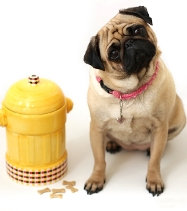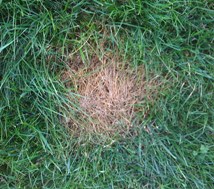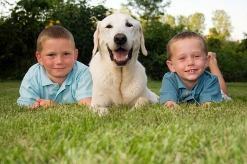How to Prevent Lawn Burn from Dog Urine
By veterinarian Steve Thompson, DVM, DABVP
 Dog urine and feces can often be a frustrating problem related to lawn care. Small amounts may produce a green-up or fertilizer effect while larger amounts often result in lawn burn or dead patches. While most burn spots will recover with time and regrowth, dead areas can be large enough in some cases to require reseeding or sodding. For homeowners who are also dog lovers, this can present a dilemma, particularly when one family member prefers the dog and another prefers a well-manicured lawn. An understanding of the interaction between dogs and the lawn can keep the yard (and family) at peace, not in pieces.
Dog urine and feces can often be a frustrating problem related to lawn care. Small amounts may produce a green-up or fertilizer effect while larger amounts often result in lawn burn or dead patches. While most burn spots will recover with time and regrowth, dead areas can be large enough in some cases to require reseeding or sodding. For homeowners who are also dog lovers, this can present a dilemma, particularly when one family member prefers the dog and another prefers a well-manicured lawn. An understanding of the interaction between dogs and the lawn can keep the yard (and family) at peace, not in pieces.
Understanding the Causes
The fundamental problem with the presence of urine or feces on the lawn is related to the nitrogen content and concentration of these waste products. Urine, when produced as a waste product in animals, primarily removes excess nitrogen from the body via the kidneys. Nitrogen waste products are the result of protein breakdown through normal bodily processes. Carnivores, including cats and dogs, have a significant protein requirement, and urine volume/production varies due to size and metabolism. Urine is a more serious problem for lawns because it is applied all at once as a liquid fertilizer, whereas feces slowly releases the waste products over time. Since stools are usually solid, owners have the option of frequent manual removal. With more time for the nitrogen waste to dissolve into the lawn, stools that are frequently removed damage lawns less than urine.
Young dogs of both sexes frequently squat to urinate. Leg lifting is often learned by male dogs around a year of age; castration or neutering does not seem to affect nature’s timetable related to this behavior development. While most male dogs will hike their leg and mark once they are over a year of age, a few will continue to squat when urinating, which is more common in female dogs. Female dogs may also mark although less commonly than male dogs. Once dogs begin urine marking, they often utilize many and numerous scent posts resulting in numerous, small volume urinations rather than large volume puddles. Grass can handle small volume nitrogen bursts easier than fertilizer overload. Unfortunately, the young bush, shrub, vine or tree sprout that becomes a marking post may have nitrogen (fertilizer) overload with repeated marking and may die if continually "marked."
The primary concern in addressing urine damage to lawns is minimizing thenitrogen concentration added to the lawn at any single time. Female dogs, being less likely to urine mark and more likely to squat, are the primary culprits of lawn damage since they will urinate anywhere on a lawn and usually all at once. This results in a single nitrogen dump confined to a small patch of grass. The brown spot that result will often have a green ring around the outside. The nitrogen overload at the center causes the burn, but as the urine is diluted toward the periphery, it has a fertilizer effect. This characteristic brown spot, green ring pattern has been called "female dog spot disease" by some horticulturists. As might be expected, lawns are most susceptible to nitrogen burns when standard fertilizers are maximized in the lawn. Homeowners making the extra effort to have a green lawn may be quite discouraged by their neighbor’s dog damage or their own housepet’s potty residue.
since they will urinate anywhere on a lawn and usually all at once. This results in a single nitrogen dump confined to a small patch of grass. The brown spot that result will often have a green ring around the outside. The nitrogen overload at the center causes the burn, but as the urine is diluted toward the periphery, it has a fertilizer effect. This characteristic brown spot, green ring pattern has been called "female dog spot disease" by some horticulturists. As might be expected, lawns are most susceptible to nitrogen burns when standard fertilizers are maximized in the lawn. Homeowners making the extra effort to have a green lawn may be quite discouraged by their neighbor’s dog damage or their own housepet’s potty residue.
Speculation on the actual cause of the lawn burn has resulted in numerous theories on what else in the urine may be contributing to the damage. Dr. A.W. Allard, a Colorado veterinarian, examined numerous variations in dog urine and the effects on several common lawn grasses.1 His results support the fact that volume of urine (nitrogen content) and urine concentration had the most deleterious effects on lawns. The pH of the urine did not have any variable effect nor did common additives designed to alter the urine pH. Of the four grasses tested, Festuca sp. var. Kentucky 31 (fescue) and Lolium perrene (perennial ryegrass) were the most resistant to urine effects. In fact, the urine routinely produced a fertilizer effect on these grasses at diluted concentrations. Poa pratensis (Kentucky bluegrass) and Cynodon sp. var. Fairway (bermudagrass) were very sensitive to any urine concentration and severe burns resulted, persisting greater than 30 days after initial exposure to even four ounces of diluted urine. Even on the most urine resistant grass tested (fescue) urine concentration was a bigger problem than urine volume. Concentrated urine with volumes as little as 30cc (one ounce) caused lawn burn even on fescue grasses.
Problem Area Avoidance Techniques
Where applicable, fences can be used to keep neighboring dogs from eliminating on the lawn. Advising neighbors of the legality of leash laws, where applicable, can restrict damage to areas near sidewalks and on tree lawns/median right of ways. Unfortunately, no repellents are universally effective although a variety of home remedies have been tried. Hot and bitter products are most likely to have taste or odor aversive properties to dogs. Most repellents function better as taste repellents than to touch or odor repellents. Some odor repellents may actually encourage a dog to overmark the strange smell. Some of the better known commercial repellents have these limitations as well. A newly developed motion activated sprinkler, primarily designed to keep cats and rabbits out of gardens, may have benefits for some yards. The sprinkler, may provide benefit in small yards or at corners of front yards where damage is most likely to occur; however, the presence of numerous squirrels, stray animals or children may result in over-watering and very high water bills if they continuously trigger this device.
In many cases, the problem dog is a housemate to the homeowner. While somewhat time-consuming, walking the dog to a park or field away from the house is a simple remedy to this. The time can be well spent since exercise has physical and emotional benefits for both dogs and their owners. Homeowners are encouraged to choose an appropriate destination and not create problem lawns elsewhere that may affect the overall aesthetics of the neighborhood.
A more feasible approach may be to train the pet to eliminate in a designated area of the yard. This area would be a landscaped area specifically designed for the dog. It will need a substrate like pea gravel or mulch that the dog finds acceptable and may even include a marking post like a large boulder, bird bath, lawn ornament, or even faux hydrant. Collecting the dog’s urine in a cup and using it in this area for several days can provide some odor attractant value to this area. Feces can also be collected and transported to the new, designated area. Consistency for at least 2-3 weeks is important to establish this as a routine, trained behavior; several months may be necessary in some cases. Initially, training can occur with the dog on a short leash and food rewards employed to encourage use of this area. Dogs should not be unsupervised in the yard while this initial training is occurring. It is often easier to train a young puppy to a particular ground texture than an adult dog, but never impossible in any age dog. A variable reward system utilizing one standard treat if urinating anywhere outside and several treats or a special treat if in the designated area can be helpful in this process and avoid confusing the dog regarding the new housebreaking rules. Excessive food rewards in the form of meat or protein products will contribute to increased nitrogen content in the urine. Dogs that are being obedience trained should not be trained with treats on the lawn during this housebreaking or pets and reward systems can really become confused. Many dog owners will also find it helpful to train their dog to an elimination command during this time. Common commands might include: Potty, Piddle, Do Your Business or Hurry Up, etc. and take less time to accomplish the task when inclement weather is present or time schedules are busy.
Dietary Modification Techniques
A great many dietary modifications for dogs have been tried, often based on home remedies or anecdotal experience. A veterinarian should always be consulted prior to making any dietary modifications, whether they include additions or subtractions from standard nutrient guidelines. As stated earlier, the pH of the urine has little or no effect on the urine damage to the lawn. The addition of acidifying agents, including nutritional supplements like D-I, Methionine (Methioform), Ascorbic Acid (Vitamin C), or fruit juices will have no benefit for this problem and may predispose the dog to an increased incidence of certain bladder stones. Likewise, alkalinizing agents, including baking soda and potassium citrate can predispose to other types of bladder stones or infections. The addition of any of these supplements has enough potential to cause harm, with limited to no known benefit for the lawn, and are not recommended.
When owners have reported successes, as is sometimes the case on internet forums, liquids likely improved the situation because the urine concentration after treatment was diluted. Safer ways to accomplish more dilute urine include feeding canned food, moistening dry food with water prior to feeding and adding salt or garlic salt to the regular food. One particular home remedy, tomato juice, likely has its primary benefit through both increased salt and water intake. While salt will make the dog drink more and dilute the urine, increased salt intake can cause problems for dogs with existing kidney or heart conditions. Owners should not alter their dog’s diet without consulting with their veterinarian.
Dogs with more dilute urine may have to urinate more frequently as well and need more frequent elimination opportunities. While specific breed differences haven’t been noted, smaller dogs produce less urine than larger dogs so are dumping less nitrogen waste. Dogs with bladder infections often demonstrate an urgency to urinate and typically squat several times, leaving small amounts or drops each time. These dogs may be less of a problem for lawns than normal dogs who empty their whole bladder in one sitting. Dog owners who actually note that their dog’s urine is no longer causing lawn burn, without having made any changes, should have their dog examined by their veterinarian and a urinalysis performed to make sure there are no medical conditions causing this change.
The other option to consider besides diluting the urine is to reduce the amount of nitrogen waste being dumped in the urine. The average family dog doesn’t have the activity level that requires as high a protein level as most commercial maintenance dog foods provide. Although, dog food purchasing often reflects consumer perception that high protein equals better food, in fact moderate to low protein foods are often adequate for all but the most energetic, working and hunting dogs. When examining a food label, protein content must be compared on a dry matter basis and unfortunately, it is not like comparing apples to apples. Dry foods vary in how much moisture they have, so the protein percent listed can’t be immediately compared to all other foods. Canned foods will have a much lower protein percent listed than dry foods but also have much higher water content.
The quality of the protein also has an impact since some proteins are highly digestible, meaning less is dumped in the feces and possibly the urine, than other proteins. In general, the premium and super premium pet foods, available from pet stores and veterinarians, will have higher quality protein and more digestible proteins than standard grocery store brands. The higher digestibility translates into smaller fecal size as well. It is probably best to discuss individual pet needs with a veterinarian or nutrition consultant in the practice to determine what is the best fit, based on feasibility, palatability and economics. In many cases, if a dog food is currently providing good, overall nutritional support for the pet, diluting the urine by simply adding water to the food may be the easiest place to start.
Repair/Recovery of Damage Area
 A leash can function to bond owners to their dogs and increase the time pets spend interacting with their owners. A leash can also be part of a responsible neighbor policy, be a great training aid, and is also one of the best ways to be at the site to intervene when urinations occur. Watering the spot after urinations will accomplish the dilution with no ill effects on the dog. Dr. Allard’s study looked at watering fescue at different intervals following urination. Water volumes three times that of the urine were used to assess their dilution effects. A fertilizer effect rather than burn was noted when the site was watered at any time up to 8 hours after the urination. When the delay in watering was extended to 12 or more hours, progressively worse burns were noted. It appears that routine watering of the grass in early mornings would not be sufficient to prevent all urine burns.
A leash can function to bond owners to their dogs and increase the time pets spend interacting with their owners. A leash can also be part of a responsible neighbor policy, be a great training aid, and is also one of the best ways to be at the site to intervene when urinations occur. Watering the spot after urinations will accomplish the dilution with no ill effects on the dog. Dr. Allard’s study looked at watering fescue at different intervals following urination. Water volumes three times that of the urine were used to assess their dilution effects. A fertilizer effect rather than burn was noted when the site was watered at any time up to 8 hours after the urination. When the delay in watering was extended to 12 or more hours, progressively worse burns were noted. It appears that routine watering of the grass in early mornings would not be sufficient to prevent all urine burns.
The use of gypsum or lime has been advocated but it is uncertain exactly what mechanism this would have in helping prevent urine damage. Improved soil quality over time may result in better drainage and less urine concentration at the grass and root level, but additional information is needed in this area.
Lawn burn, when mild, will often repair itself over time, especially in the case of the warm-season turf grasses that spread by stolons and rhizomes. Dark green spots and taller grasses may remain for several weeks. Sodding can be a quick way to patch severely damaged individual areas that would otherwise be invaded by weeds.
While a high fence and dog-less lifestyle can ensure that "female dog spot disease" is not a problem in your yard, homeowners and dog lovers have several practical options available to manage this problem. Communications should remain open whenever family conflicts arise with various priorities. Coordinating a comprehensive program with your county or state extension horticulturist or lawn care resource and your veterinarian can keep your four-legged friend on good terms and out of the dog house, so she, too, can enjoy romping in your well manicured yard.
Resource:
- Allard, AW. Lawn burn and dog urine, Canine Practice, March/April 1981;8;(2);26-32.
Steve Thompson, DVM, - Diplomat ABVP (Canine/Feline specialty). Clinical Associate Professor. Director - Pet Wellness Clinic. Companion Animal Medicine & Behavior. Veterinary Teaching Hospital - 625 Harrison St - West Lafayette, Indiana 47907-1249. This email address is being protected from spambots. You need JavaScript enabled to view it.
You May Also Like These Articles:
Foxtails: A Summertime Hazard for Dogs
How to Stop a Dog from Digging
Springtime Hazards for Dogs - Slideshow
Disclaimer: This website is not intended to replace professional consultation, diagnosis, or treatment by a licensed veterinarian. If you require any veterinary related advice, contact your veterinarian promptly. Information at DogHealth.com is exclusively of a general reference nature. Do not disregard veterinary advice or delay treatment as a result of accessing information at this site. Just Answer is an external service not affiliated with DogHealth.com.
Notice: Ask-a-Vet is an affiliated service for those who wish to speak with a veterinary professional about their pet's specific condition. Initially, a bot will ask questions to determine the general nature of your concern. Then, you will be transferred to a human. There is a charge for the service if you choose to connect to a veterinarian. Ask-a-Vet is not manned by the staff or owners of DogHealth.com, and the advice given should not delay or replace a visit to your veterinarian.


